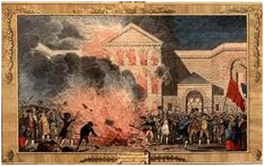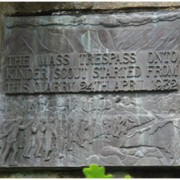MONTHLY BLOG 12, WHAT IS A RIOT?
If citing, please kindly acknowledge copyright © Penelope J. Corfield (2011)
What’s a riot? Some people prefer to name the recent disorder in numerous English cities between 6-10 August 2011 as ‘looting sprees’. But there is no absolute right-or-wrong definition.
Riots usually involve crowds in substantial numbers, who are flouting the law in a tumultuous and out-of-control manner. They may or may not have a specified aim. Yet if disorderly crowds resort to public displays of criminal violence against people and/or property, then their actions are riotous.
Mass campaigns of civil disobedience do not fall into the same category. In such cases, campaigners may also break the criminal law. An example was the 1932 mass trespass on Kinder Scout in the Peak District. The action, however, was conducted in an orderly way, to make their campaign point. The ramblers were asserting their right of access to the countryside (see plaque) – a right that was eventually confirmed by legislation.1

Running wild:
It is the out-of-control element which makes riots not only nerve-tingling for rioters but also, potentially, exhilarating. Normal order is being flouted. People make snap decisions, in strange circumstances. Generally, the excitement is greatest in the early stages of a riot, before official repression follows.
One historical example displayed carnival elements. At the Nottingham Goose Fair Riots in 1764, the crowd rebelled at a sudden steep rise in food prices. Market stalls were ransacked and giant cheeses were rolled down the street. One struck the Mayor, flattening his dignity. Although serious in intent, the crowd’s antics parodied the Fair’s normal carnival atmosphere.
That element of being out-of-control makes riots into very blunt instruments as a form of political protest. They are hard to direct and focus. Thus, while riots may start as demonstrations of public anger on classic issues (eg: politics; religion; policing; high prices; unemployment; or any combination of those), they often develop, if unchecked, into disorganised violence and attacks on property. As things escalate, blazing buildings and uncontrolled streets (see illustration from London in August 2011) mimic scenes of disasters or war zones. In one sense, the flames are an emphatic display of anger. Yet any issues at stake in the riot are obscured by the urgent need to restore order.

Repressing riots:
Repressing riots in Britain was, historically, governed by special legislation. Under the 1715 Riot Act,2 a disorderly and threatening mass of twelve or more people was not held to be riotous until the Mayor or local magistrate had read the Riot Act – and one full hour had elapsed. That way, people were warned.
If the crowds did not disperse, the authorities were then entitled to use force, in the form of armed troops. Shots were fired; and sometimes one or two rioters lost their lives. State violence in retaliation hit its peak in the aftermath of London’s Gordon Riots in June 1780. These began as anti-Catholic demonstrations but, while the authorities dithered, ‘King Mob’ took over. Prisons were thrown open. Wealthy residences, including that of the Lord Chief Justice, were sacked. And the Bank of England was attacked. When the troops were finally summoned to restore order, they killed several hundred people and wounded as many again. It was at once the apogee of political violence – and its nadir, since these riots alienated many of the original protestors.
 However, the authorities needed – and still need – to strike a balance. On the one hand, they had to restore civil peace. On the other hand, it’s always wise not to provoke more people to join the mayhem. The use of troops today remains a reserve power. But riot control, in a democracy, is essentially viewed as a task for policing – and, ultimately, for community self-control.
However, the authorities needed – and still need – to strike a balance. On the one hand, they had to restore civil peace. On the other hand, it’s always wise not to provoke more people to join the mayhem. The use of troops today remains a reserve power. But riot control, in a democracy, is essentially viewed as a task for policing – and, ultimately, for community self-control.
So do riots ‘work’?
Because riots are hard to control and often provoke a backlash, riots are usually taken as a negative form of campaigning. For that reason, organised protestors generally try hard to prevent marches and demonstrations from turning violent. Nonetheless, the authorities do also pay attention to the crowd grievances, if only through prudence. For example, historic riots in protest at high food prices often encouraged magistrates to bring extra grain into town. Or, much more recently, the 1990 riot in Trafalgar Square against the Poll Tax was one of the salient factors which helped to bring about that tax’s demise. Hence activists sometimes comment pointedly that violence attracts a greater degree of attention from the powers-that-be than does civil protest.
So riots can ultimately be defined as inarticulate (or non-articulated) forms of protest, which take the form of collective violence. They include riots which end or even start with looting. In sum, all upheavals make a point. They shock the complacency of the powers-that-be. But riots don’t usually ‘win’ directly. Instead, they draw attention to an issue or range of issues. In the old days, rioters were suppressed without too much angst. They were rarely voters. What democracies decide to do about those non-articulated issues, however, is much more significant. It is unlikely that there will be plaques to commemorate the 2011 riots. But there will be responses – and repression alone won’t suffice.
1 The National Parks and Access to the Countryside Act (1949) laid the foundation for all subsequent legislation, most recently the Countryside and Rights of Way Act (2000).
2 This legislation remained on the statute book until 1967, when it was replaced by the Criminal Law Act.
For further discussion, see Twitter
To read other discussion-points, please click here
To download Monthly Blog 12 please click here

